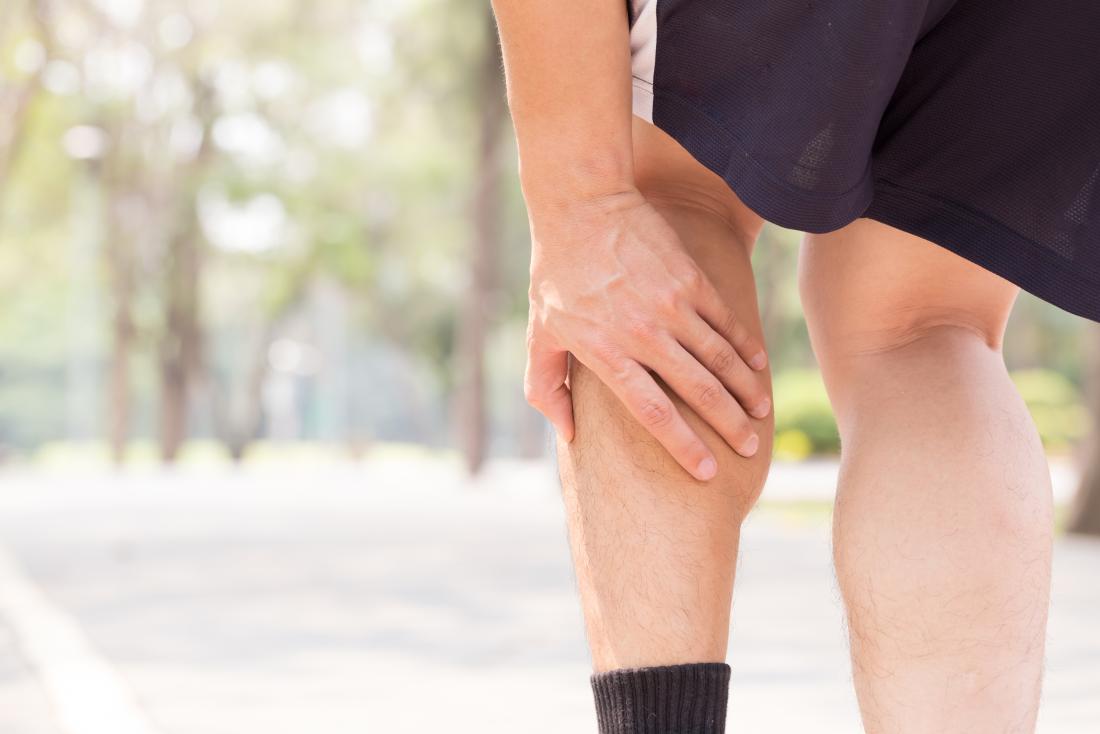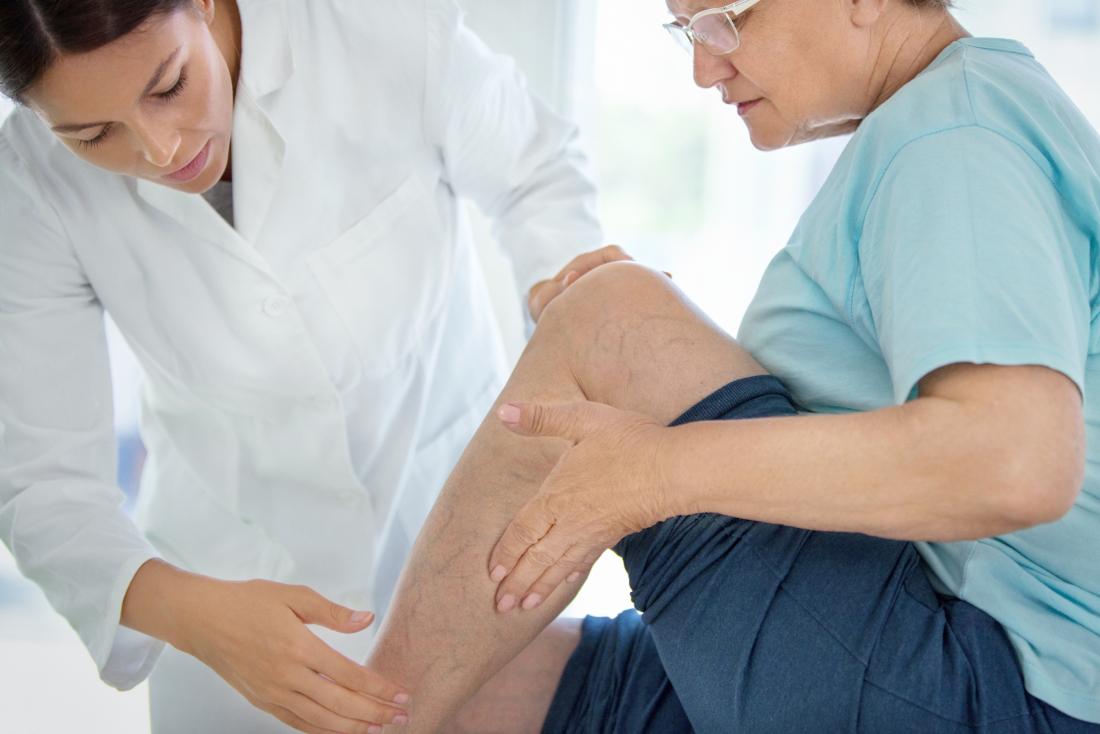You Better Like Thaty Calf Again
Calf pain can be a balmy nuisance or be astringent enough to prevent a person from walking.
In that location are a diversity of conditions that can bear upon the calf muscles, as well equally the claret vessels and other structures around it. Fortunately, many of the causes of calf hurting are easily treatable.
A multifariousness of atmospheric condition and situations can cause calf pain, including:
1. Muscle cramp

Muscle cramps in the calf are a common complaint for those who exercise frequently.
Calf muscle cramps are commonly temporary merely tin can crusade pregnant hurting and discomfort.
Causes of dogie muscle cramps include:
- dehydration
- a loss of electrolytes through sweating
- lack of stretching
- prolonged physical activeness
- weak muscles
2. Muscle strain
A calf muscle strain occurs when the muscle fibers in the calf tear either partially or completely.
The symptoms will vary depending on the severity of the strain, but nearly people will experience sudden, precipitous pain and tenderness at the calf muscle site.
iii. Arterial claudication
A person may experience dogie pain due to narrowing or blockages in the arteries that supply blood catamenia to the legs. This is known as arterial claudication.
Arterial claudication may crusade pain while walking, every bit this motion requires blood to menstruation to the lower legs.
If the blood has difficulty moving due to narrowing (claudication), a person may experience dogie hurting.
A person with arterial claudication will feel no discomfort at rest, but pain after a few minutes of walking.
4. Neurogenic claudication
Neurogenic claudication occurs when the nerves that go to the legs are pinched, affecting their ability to communicate with the lower legs.
Neurogenic claudication is often due to a condition chosen spinal stenosis.This condition occurs when the bones in the spinal column narrow, placing extra force per unit area on the fretfulness. Sciatica is one example of neurogenic claudication.
In addition to dogie hurting, neurogenic claudication symptoms include:
- pain while walking
- hurting afterwards prolonged continuing
- hurting that too occurs in the thighs, lower back, or buttocks
- pain that usually improves when a person leans forwards at the waist
A person may also experience calf pain from neurogenic claudication when at rest.
5. Achilles tendinitis
The Achilles tendon is a tough, fibrous band that connects the calf muscle to the heel bone.
If a person's calf muscles are peculiarly tight, this may put actress pressure on the Achilles tendon. As a effect, a person can feel calf pain.
People are more likely to experience Achilles tendinitis if they have recently started an practice program or they perform repetitive exercises.
Frequent stretching tin can oft help to reduce symptoms.
vi. Compartment syndrome

Persistent pain in the calf should be addressed by a doctor.
Compartment syndrome is a painful condition that can occur in the dogie muscle or in both legs, usually after a person has experienced a trauma or severe injury.
It occurs when backlog blood or fluid builds up underneath a ring of tough tissues in the body that cannot stretch very well. This fluid places extra pressure on the fretfulness and blood vessels in the lower leg, causing hurting, swelling, numbness, and tingling.
Some other grade of compartment syndrome is chronic or exertional compartment syndrome. This type occurs when a person experiences pain while exercising.
Symptoms associated with chronic compartment syndrome include numbness, visible bulging or enlarging of muscles, or trouble moving the foot.
vii. Diabetic neuropathy
Diabetic neuropathy is a status that occurs when a person experiences nerve impairment related to diabetes.
Frequently high blood saccharide levels can harm the body's nerves, normally showtime with the hands and feet.
Sometimes, the tingling and numbness can cause shooting hurting and discomfort that radiates to the calf muscles.
eight. Plantar fasciitis
Plantar fasciitis is a status that affects the plantar fascia tissue located on the bottom of the human foot.
If the calf muscles are too tight, a person may be more than probable to experience plantar fascia because the calf muscles cannot back up the pes.
The near common symptoms of plantar fasciitis are foot pain when waking and difficulty flexing the foot.
9. Varicose veins
Varicose veins are enlarged veins that often bulge from the legs and may await like cords. They develop when damaged valves in a person's veins allow blood to backflow.
Factors that contribute to varicose veins include:
- historic period
- a family history of varicose veins
- hormone fluctuations
- pregnancy
- obesity
- lack of physical activity
Varicose most commonly appear in the legs and tin can cause pain, throbbing, cramping, and aching.
10. Deep vein thrombosis
Deep vein thrombosis (DVT) is the result of a blood jell that forms in i of the veins in the leg. This condition can crusade severe hurting and bear upon blood flow to the legs.
People are more likely to develop DVT if they have been sitting for long periods, such as on a flight, or if they have high blood pressure or blood clotting disorders.
Symptoms of DVT include calf pain that usually gets worse when continuing or walking. A person's leg may too keen and accept a red or inflamed area due to the problems with blood flow.
Treatment for dogie pain will depend on the underlying crusade.
People can treat calf hurting that is the result of injury or overuse using the Cost method. This stands for:
- Protection: Apply a cloth bandage, splint, or immobilizer to the human foot, ankle, or calf to protect the injury and allow the muscles to remainder.
- Balance: Avoid using the calf muscle more than necessary.
- Ice: Apply a cloth-covered ice pack for x to 15 minutes at a time to help reduce inflammation. Ice packs are available to buy in pharmacies and online.
- Compression: Wrap the dogie in a stretchy, tight cast or wear a compression stocking to reduce swelling.
- Tiptop: Drag the leg on pillows to help promote circulation and reduce swelling.
Other causes of calf pain may be treated with medications or other medical procedures, depending on the underlying cause.
Warming up by walking at a moderate pace before engaging in more than intense exercise tin help to prevent muscle strain injuries.
In add-on to these measures, a person may also choose to do some gentle stretching to reduce muscle tightness after exercise.
A person should always check with their doctor before beginning a stretching routine to ensure the stretches volition non beal an injury.
Useful stretches for calf hurting include:
Stretching afterwards exercising may also help to prevent muscle tightness and discomfort.
A person should seek emergency medical treatment if they suspect they accept DVT. The symptoms of DVT include pain, swelling, and warmth in i leg.
Other signs a person should seek emergency treatment for calf pain include:
- fever that is greater than 100°F
- bloated leg that is stake or absurd to the affect
- sudden extreme swelling in the legs
Some causes of calf pain warrant a trip to the doctor's part during regular business hours. These include:
- pain while walking
- unexplained leg swelling
- varicose veins that are very painful
- symptoms that exercise not become meliorate after a few days of at-home care
If a person has concerns almost bothersome or ongoing calf pain, making an appointment to see a doctor tin can aid provide peace of mind.
A doc will carry out a physical exam to determine whether a pulled or strained muscle is the trouble.
If the md finds that the effect is more than astringent, they may club a musculoskeletal ultrasound browse. An ultrasound would be able to identify the following:
- arterial claudication
- Achilles tendinitis
- diabetic neuropathy
- plantar fascia
- deep vein thrombosis
A musculoskeletal ultrasound can too provide guidance regarding injection therapy.
Read the commodity in Spanish.
Source: https://www.medicalnewstoday.com/articles/321446
0 Response to "You Better Like Thaty Calf Again"
Post a Comment